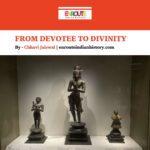Maharaja Ranjit Singh’s Contribution to the Art of the Golden Temple
- EIH User
- April 6, 2023
Article Written By EIH Researcher And Writer
Tithi Chatterjee
There are very few people who have not heard about the Golden Temple. Due to its picturesque beauty and golden exterior, Sri Harmandir Sahib also known as Sri Darbar Sahib is globally famous as the Golden Temple. Devotees around the globe aspire to travel to Amritsar and offer prayers at Golden Temple.
With his devotion and zeal for religion, Maharaja Ranjit Singh (1799–1839) contributed a brilliant chapter to the Temple’s art and architectural heritage. Maharaja Ranjit Singh took charge of the initiative to adorn the temple, and to cover the expenditures, he made an initial contribution of Rs. 5,000,000. It is known that he oversaw the reconstruction of the sanctuary, which required significant alterations, additions, and ornamentation, beginning in 1802. The Golden Temple’s architectural fabric likely received a new direction in terms of the decor during this activity. Since then, it appears that no significant alterations to the Golden Temple’s design have been made, though minor repairs may occasionally have been necessary due to the effects of time and weather. This article will explore the artistic elements of the temple contributed by the Maharaja.
The majority of the fresco artworks are adaptations of Mughal, Persian, and Hindu themes in the Golden Temple. However, the unique environment and arrangement of the plants, flowers, birds, and creatures reveal a certain distinctiveness. These show dimensions with deeper meaning rather than simply repeating the old theme in the old fashion. The Sikh artists widened the Hindu fresco canvas from the Krishna sect to the monotheistic movement. The artists adopted the essence of these paintings and created their versions which were more abstract to connect them with their monotheistic philosophy. The artists incorporated geometric patterns and relief carvings of gold flowers with dazzling colors into the Mughal Mohrakashi (fresco painting) style but they also created beautiful examples of their work by diving deeply into the spirit of the art. The mural artwork’s aesthetic value is enhanced by gorgeous borders made in traditional patterns. When everything is considered, the Golden Temple’s contribution to the art of fresco painting rests in the preservation of local tradition and the development of the work of the Kangra and related schools. Numerous fresco paintings feature animals that appear to be from real life in addition to floral representations.
Only six colors—red, yellow, blue, green, black, and white—were used in these fresco paintings. The majority of the colors were made from materials like rocks, soil, leaves, flowers, charcoal, and soot.
The gach (limestone) work in the interior of the Temple was primarily completed by the Naqqases (painters) who were tasked with embellishing and beautifying the sacred site. They also inserted bits of glass and mirror into the limestone, which was later painted in golden and other hues.
Floral patterns with animal motifs interwoven are decorations that belong in the category of mural art. The walls are covered in about three-hundred patterns, which resemble hung Persian carpets from a distance. The naqqashes, or painters, of these patterns, created their terminology to depict them. The most well-known of these is dehin which is a means of expression for the imaginative study of the artist’s idealized shapes. Dehin is based in Gharwanjh. This decorative device also involves creatures wrestling in knotted fashion. Patta is an ornamental border pattern that is frequently portrayed by creepers. Additionally, there are paintings inspired by marine creatures.
The only mural that features human figures depicts Guru Gobind Singh riding a horse and is located on the wall behind the northernmost narrow staircase going to the top of the shrine. The late Bhai Gian Singh Naqqash claimed that it was created by a Kangra artist who Ranjit Singh specifically hired for this project. It is said to be a replica of a miniature painting that Ranjit Singh had planned to have copied to create a mural for the Golden Temple. The original miniature painting was in the possession of Raja Sansar Chand of Kangra. The mural was painted by the painter’s grandson because the artist of the miniature in issue had already passed away. However, the painter’s identity is unknown. Maharaja Ranjit Singh sent a local artist called Sher Singh to the fort in Lahore in the second decade of the nineteenth century, where he created some exquisite floral designs. He was hired to help with the Golden Temple’s beautification after the Maharaja was exceptionally pleased.
Ranjit Singh did not like the idea of one of his employees having the same name as one of Maharaja’s sons, who was also called Sher Singh. So he gave the artist the new name Kehar Singh. He spent a good deal of time working in the sanctuary. Kehar Singh taught this skill to two of his nephews, Sardar Kishan Singh and Sardar Bishan Singh, who both achieved greatness in the field of mural painting. They also learned the Kangra art of mural painting.
Under the direction of Badaru Mohiu-din, the Chief Architect, Muslim masons from Chiniot (Pakistan) carved floral decorations on the walls of the ground level (interior and exterior). Following the passing of Maharaja Ranjit Singh in 1839, Sardar Bhagwan Singh Jamadar, Sardar Mangal Singh Ramgarhia, and Rai Bahadur Kalyan Singh were tasked with finishing the beautification work. And the native Sikh and Hindu craftsmen finished it.
The two main stereotypes of Sikhs—that of saints and that of soldiers—are recalled by the Sikhs’ classical art. But these beautiful iconographies are grounded in ideals that transcend religiosity and strength of forces. Simply put, these values are an all-encompassing spirituality that transcends the rigid boundaries of class, race, or gender and is based on a deep reverence for the brilliance of the human spirit and the truth of God.
Bibliography
- Arshi, P.S. The Golden Temple: History, Art, and Architecture. New Delhi: Harman Publishing House, 1989; The Golden Temple – History Art And Architecture : www.DiscoverSikhism.com : Free Download, Borrow, and Streaming : Internet Archive
- Brown, Kerry. ed. Sikh Art and Literature. New York: Routledge, 1999; Sikh art and literature: Free Download, Borrow, and Streaming : Internet Archive
- “Art and Architecture of Harmandir Sahib (Golden Temple, Amritsar).” Golden Temple Heaven on Earth. June 23, 2015; Art and Architecture of Harmandir Sahib (Golden Temple, Amritsar) – Golden Temple Heaven On Earth (wordpress.com)
- “The Golden Temple Amritsar.” Golden Temple Amritsar. Org; Golden Temple History | History of Harmandir Sahib (goldentempleamritsar.org)

















